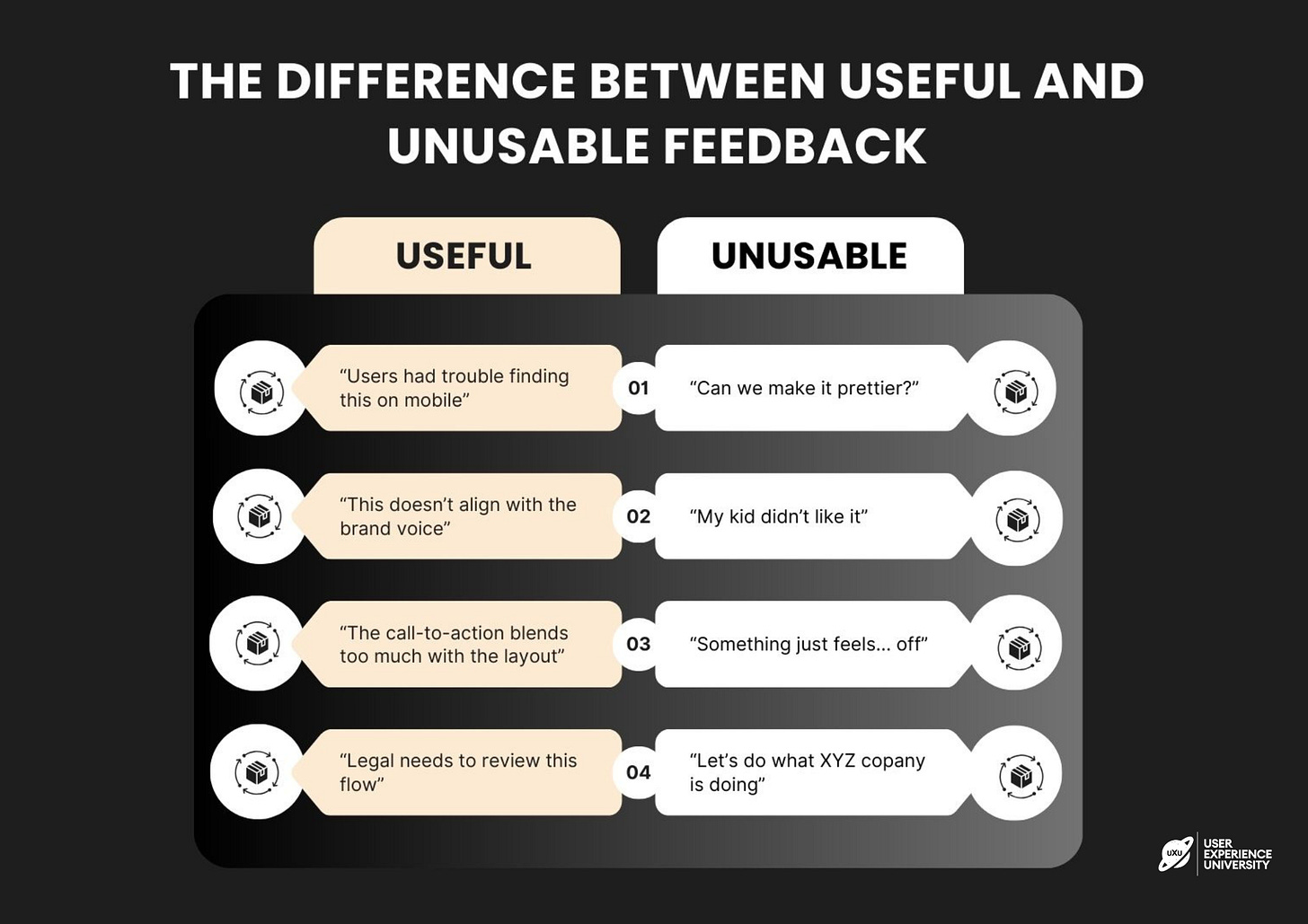Designing in the Age of Too Much Feedback
The Hard Truth About UX Rejections
You finish a design. You’re feeling good.
Then it starts.
“Let’s make it pop.”
“Can we add a carousel?”
“Maybe move that button... somewhere else?”
Sound familiar?
In a world where design has become more visible — and more people feel entitled to weigh in — the real challenge isn’t getting feedback. It’s filtering it.
Today, we’ll tackle what happens when you’re stuck between endless opinions and actual user needs… and how to push good work forward without losing your mind.
Why Feedback Feels More Overwhelming Than Ever
The Difference Between Useful and Unusable Feedback
How to Handle Stakeholders Who Aren’t UXers
Creating Boundaries Without Creating Conflict
What to Say When Feedback Isn’t Actionable
UXCON '25 Spotlight -Save $50. Early Bird is Back — 4 Days LEFT.
Resource Corner
Why Feedback Feels More Overwhelming Than Ever
Design feedback used to come from a small, focused team.
Now? You’re fielding input from marketing, sales, product, support, and someone’s cousin who “has a good eye.”
Here’s why:
Design is more visible than ever before
Tools like Figma make collaboration instant
Everyone feels responsible for “experience”, but not always in a helpful way
Stakeholders often don’t know the difference between a suggestion and a requirement
It’s not just volume. It’s velocity.
And if you’re not careful, your clarity gets buried in comments.
The Difference Between Useful and Unusable Feedback
Not all feedback is created equal. Here's a simple way to sort it:
Good feedback is tied to goals, users, or constraints.
Bad feedback is vague, subjective, or trendy with no substance.
How to Handle Stakeholders Who Aren’t UXers
A product manager with 20 tabs open.
A CMO with strong opinions on fonts.
A founder who dreams in gradients.
Welcome to stakeholder feedback.
The key isn’t avoiding it.
It’s guiding it.
Tips that help:
Give context first. If you walk into a meeting showing solutions, they’ll critique layout. Show the problem and constraints instead.
Ask for feedback on what matters. “I’m looking for input on clarity, not color. Does the information flow make sense?”
Use your research as armor. Show user data. It’s harder to argue with lived experience than with opinion.
Creating Boundaries Without Creating Conflict
It’s hard to say no — especially to someone above your pay grade.
But the more vague feedback you accept, the more chaotic your process becomes.
Try these boundary phrases:
“That’s helpful. Let me explore that idea and test it with users before we decide.”
“That’s outside the scope of this sprint. Can we document it for later?”
“I’m hearing a lot of suggestions. Can we align on the main user problem first?”
You don’t need to fight every suggestion.
You just need to redirect the energy to where it helps most.
What to Say When Feedback Isn’t Actionable
Sometimes, feedback is too vague to use — but too political to ignore.
Here’s how to respond without derailing:
What they say:
“Something feels off.”
What you say:
“Can you share more about what you were expecting to see here?”
What they say:
“Let’s make it more fun.”
What you say:
“Tell me more about what ‘fun’ looks like to you in this context. Are you thinking tone, animation, or something else?”
You’re not being difficult. You’re being precise.
UXCON '25 Spotlight: Designing in High-Pressure Environments
At UXCON '25, we’re digging into the real-life tension between creativity and collaboration.
You’ll hear from UX professionals who’ve:
Navigated strong opinions from leadership without losing momentum
Transformed vague feedback into sharp insights
Built trust with non-designers using data, clarity, and facilitation
Early Bird is available till May 13.
Lock in Your Ticket and SAVE $50!!
That’s 4 days to make a decision that could shift your entire year.
Resource Corner
Final Thought: You’re Not Overreacting. This Stuff Is Hard.
Managing feedback is one of the least glamorous but yet one of the most important parts of your work.
You’re not just designing screens/experiences. You’re translating business goals, navigating personalities, and protecting the user’s voice in a room full of louder ones.
That’s real UX leadership.





